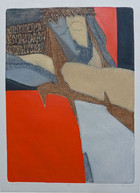Sandra Bowden
Sandra Bowden makes art out of words about words. She links letters with letters in patterned text blocks, layers book page atop book page in collages, and even turns book bindings into sculpted forms, holding everything from icons to nails. At a time when post-modernist semioticians cast doubt on language as a bearer of meaning, this American artist of faith from New England celebrates words as the chosen medium of the Judeo-Christian God who speaks and can be understood. When Bowden deconstructs texts, she transforms them into visual mediations. They become artistic variations on the Christian devotional practice of lectio divina. Letters resonate with mystical meaning like the Hebrew alphabet of Kabbalah.
Bowden’s fascination with the visual aspects of language comes out of her experience as an artist growing up in a conservative Protestant faith community, where the Bible was the sole authority and word took primacy over image. Her first exhibition at a Massachusetts Baptist Church in 1965 included the oil painting with text fragments, Ancient Writings, a marker of the course her art-making would take over the next (almost) fifty years. Bowden's interest in sacred writing inspired her to learn biblical Hebrew in 1972. She travelled to Israel in the early 1980s to study archeological sites and the Dead Sea Scrolls, resulting in a series of “lettered” landscapes. In Heavens Declare the Glory of God in the Sacred Art Pilgrim collection, the expense of sky is filled with the Hebrew text of Psalm 19.
Passages from the Hebrew Scriptures appear in other pieces on display in the image gallery, where Bowden works in two of her favorite media: collagraph printing (graphic works made from textured materials fixed on a plate) and collage (art made from assembled materials). The collagraph assemblage, Breastplate III , suggests the gem-covered vestments of the Jewish high priests, described in Exodus 39:8-14. The twelve textured color panels are inscribed with the names of the twelve tribes of Israel and the blessings the Patriarch Jacob gave to his sons in Genesis 49. In Promise, the story of Noah and the Ark in ancient Hebrew scrolls across a grid of horizontal colored stripes, recalling the rainbow that appeared after the Great Flood. (Genesis 9:13-17)
Bowden is unique among the artists in my collection in bringing together Jewish and Christian texts in her pieces. Perhaps, the best example of such interfaith art is In the Beginning Was the Word. The darkly, luminous central panel inscribed with the Hebrew text of the Creation narrative from the first chapter of Genesis is framed in a wide white margin embossed with the Greek words of the Prologue to the Gospel of John. God brings the world into being with a spoken word in the Hebrew Scriptures. The Word becomes flesh and dwells among us in the person of Christ in the the New Testament. Text comments on text like the Jewish interpretative method of Midrash.
The Hebrew and Christian scriptures also figure in the parallel collage assemblage pieces, Law and Gospel. The two richly gilded rectangles of the left panel suggest the two tablets of the Ten Commandments and are inscribed with their ancient Hebrew text. On the right, the two rectangles are transformed into four squares, representing the four Gospels of the New Testament, when cut across by a horizontal line, which forms the outline of the Cross.
Gold has figured prominently in Bowden’s sacred art palette, since she made her first trip to Europe in 1986 and was awed by the opulence of gilded altarpieces, icons, and illuminated manuscripts from the Byzantine and Medieval periods. She has paid homage to “Icons of Western Art” by incising their silhouettes into thin sheets of 22-carat gold leaf mounted on paper. This series is represented in my collection by a mixed media drawing of the San Damiano Cross from which Christ spoke to St. Francis of Assisi in 1206 and a 15th century fresco of the Annunciation by Fra Angelico. Bowden created a golden Book of Psalms, using an actual open book as her working surface. She covered its pages with raised forms suggesting Hebrew script and incised the English text of Psalm 27 on the back.
Some of Bowden’s text pieces resemble medieval palimpsests, parchment sheets where erased texts bleed through newer lines of writing. Her mixed media collagraph, Psalm XXIII, combines an early Christian image of the Good Shepherd with the partly concealed texts of the Hebrew version of the much-loved psalm and the title page of American Composer Leonard Bernstein’s musical setting of Psalm 23. The background of He Was Wounded for Our Transgressions is a facsmile of English Composer Benjamin Britten’s score of the Sanctus from his War Requiem, covered by the hand-written text of Isaiah 53 and a reproduction of a 14th century Italian Crucifix .
Crosses are an important motif in Bowden’s sacred art. Two sayings of Christ from the Passion narratives in the Gospels are the subject of cubist-styled collagraphs in my collection, which take the form of asymmetric crosses, delineated by planes of bold red. In the print, Do This In Remembrance of Me, recalling Christ’s words over the bread and wine at the Last Supper, the strong vertical lines of the right-of-center Christ image break through the long horizontal of the disciples at the table to compose a cross. The red chalice form by the Christ figure recalls the wound in his side at the Crucifixion. In It is Finished, one of Christ’s seven last words from the Cross, the torso and outstretched arm of the Crucified Christ intersect in a similarly off-center cruciform.
Bowden is a pivotal figure on the American sacred art scene. She not only makes art but was a founding member of Christians in the Visual Arts (CIVA) and has been active in the leadership of the Museum of Biblical Art (MoBiA) in New York City. She and, her husband, Bob, are dedicated collectors of sacred art, who make their pieces available to churches, schools, and universities across the country through the Bowden Collections traveling exhibitions program. Bowden’s life and art embody the scriptural text: “Be ye doers of the word and not hearers only..." (James 1:22, KJV).
Biographical and critical material taken from The Art of Sandra Bowden, edited by James Romaine. (Square Halo Books, Baltimore, Maryland: 2005).

Heavens Declare the Glory of God (1981)
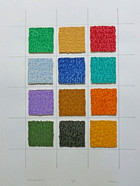
Breastplate III (1983 on)
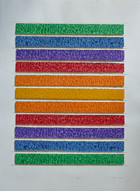
Promise
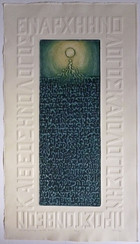
In the Beginning Was the Word (1982)

Law and Gospel (1994)
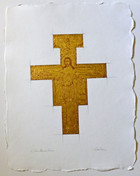
St. Francis Cross (1997 on)
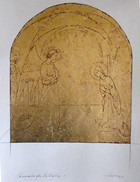
The Annunciation (After Fra Angelico)
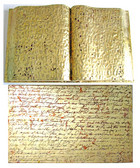
The Book of Psalms (front and verso)
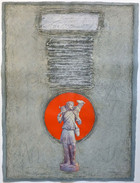
Psalm XXIII (1990)
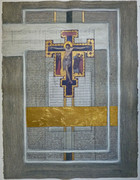
He Was Wounded for our Transgressions (1992)
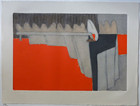
Do This in Rembrance of Me (1980)
